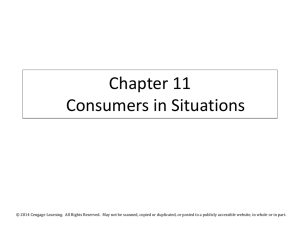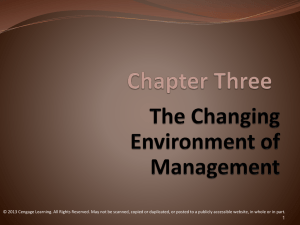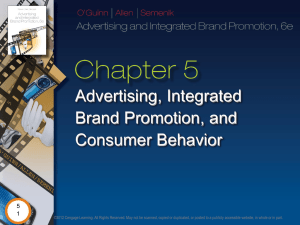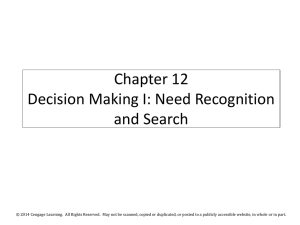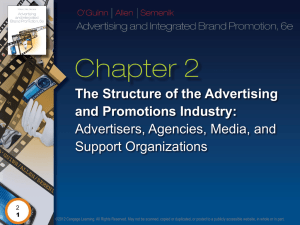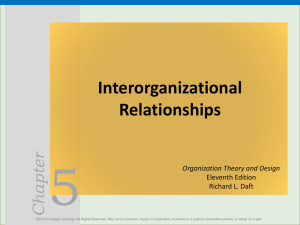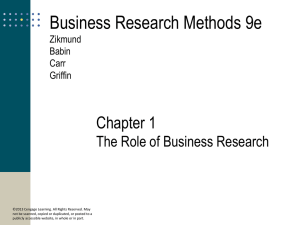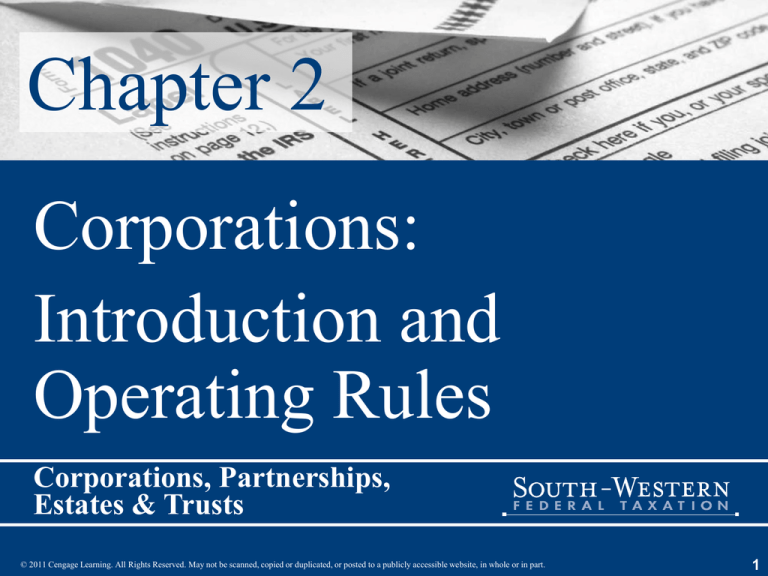
Chapter 2
Corporations:
Introduction and
Operating Rules
Corporations, Partnerships,
Estates & Trusts
© 2011 Cengage Learning. All Rights Reserved. May not be scanned, copied or duplicated, or posted to a publicly accessible website, in whole or in part.
1
Various Business Forms
•
•
•
•
•
Sole proprietorships
Partnerships
Trusts and estates
S corporations
Regular corporations (also called C
corporations)
© 2011 Cengage Learning. All Rights Reserved. May not be scanned, copied or duplicated, or posted to a publicly accessible website, in whole or in part.
2
Sole Proprietorship
• Not a separate taxable entity
• Income reported on owner’s Sch. C
© 2011 Cengage Learning. All Rights Reserved. May not be scanned, copied or duplicated, or posted to a publicly accessible website, in whole or in part.
3
Partnership
• Separate entity, but does not pay tax
• Allocates partnership income to partners
– Partners report partnership income on personal tax
returns
• Files information return (Form 1065)
© 2011 Cengage Learning. All Rights Reserved. May not be scanned, copied or duplicated, or posted to a publicly accessible website, in whole or in part.
4
S Corporation
• Separate entity, only pays special taxes (e.g.,
built-in gains)
• Allocates entity income to shareholders
– Shareholders report entity income on personal tax
return
• Files information return (Form 1120S)
© 2011 Cengage Learning. All Rights Reserved. May not be scanned, copied or duplicated, or posted to a publicly accessible website, in whole or in part.
5
C Corporation
• Separate tax-paying entity
– Reports income and expenses on Form 1120
– Income is taxed at corporate level and again at
owner level when distributed as a dividend
© 2011 Cengage Learning. All Rights Reserved. May not be scanned, copied or duplicated, or posted to a publicly accessible website, in whole or in part.
6
Dividends
• Double taxation stems, in part, from the fact that
dividend distributions are not deductible by the
corporation
• To alleviate some of the double taxation effect,
Congress reduced the tax rate applicable to dividend
income of individuals for years after 2002
– Generally, dividends are taxed at same marginal rate
applicable to a net capital gain
• Thus, individuals otherwise subject to the 10% or 15% marginal tax
rate pay 0% tax on qualified dividends received
• Individuals subject to the 25, 28, 33, or 35 percent marginal tax rate
pay a 15% tax on qualified dividends
© 2011 Cengage Learning. All Rights Reserved. May not be scanned, copied or duplicated, or posted to a publicly accessible website, in whole or in part.
7
Corporate Income Tax Rates
© 2011 Cengage Learning. All Rights Reserved. May not be scanned, copied or duplicated, or posted to a publicly accessible website, in whole or in part.
8
Nontax Issues in Selecting
Entity Form (slide 1 of 3)
• Liability
– Sole proprietors and some partners have unlimited
liability for claims against the entity
• Capital-raising
– Corporations and partnerships to a lesser extent
can raise large amounts of capital for entity
ventures
© 2011 Cengage Learning. All Rights Reserved. May not be scanned, copied or duplicated, or posted to a publicly accessible website, in whole or in part.
9
Nontax Issues in Selecting
Entity Form (slide 2 of 3)
• Transferability
– Corporate stock is easily sold, but partners must
approve partnership interest transfer
• Continuity of life
– Corporations exist indefinitely
© 2011 Cengage Learning. All Rights Reserved. May not be scanned, copied or duplicated, or posted to a publicly accessible website, in whole or in part.
10
Nontax Issues in Selecting
Entity Form (slide 3 of 3)
• Centralized management
– Corporate actions are governed by a board of
directors
– Partnership operations may be conducted by each
partner without approval by other partners
© 2011 Cengage Learning. All Rights Reserved. May not be scanned, copied or duplicated, or posted to a publicly accessible website, in whole or in part.
11
Limited Liability Companies (LLC)
• LLCs have proliferated since 1988 when IRS
ruled it would treat qualifying LLCs as
partnerships
– Major nontax advantage
• Allows owners to avoid unlimited liability
– Major tax advantage
• Allows qualifying business to be treated as a partnership
for tax purposes, thereby avoiding double taxation
associated with C corporations
© 2011 Cengage Learning. All Rights Reserved. May not be scanned, copied or duplicated, or posted to a publicly accessible website, in whole or in part.
12
Entity Classification
Prior to 1997 (slide 1 of 2)
• Sometimes difficult to determine if entity will
be taxed as a corporation
– If entity has a majority of corporate characteristics,
it is taxed as a corporation
– Most entities have the following characteristics:
• Associates
• Objective to carry on business and share profits
© 2011 Cengage Learning. All Rights Reserved. May not be scanned, copied or duplicated, or posted to a publicly accessible website, in whole or in part.
13
Entity Classification
Prior to 1997 (slide 2 of 2)
• If entity has a majority of the following
relevant corporate characteristics it is treated
as a corporation:
–
–
–
–
Continuity of life
Centralized management
Limited liability to owners
Free transferability of ownership interests
© 2011 Cengage Learning. All Rights Reserved. May not be scanned, copied or duplicated, or posted to a publicly accessible website, in whole or in part.
14
Entity Classification
After 1996 (slide 1 of 2)
• Check-the-box Regulations
– Allows taxpayer to choose tax status of entity
without regard to corporate or noncorporate
characteristics
– Entities with > 1 owner can elect to be classified as
partnership or corporation
– Entities with only 1 owner can elect to be
classified as sole proprietorship or as corporation
© 2011 Cengage Learning. All Rights Reserved. May not be scanned, copied or duplicated, or posted to a publicly accessible website, in whole or in part.
15
Entity Classification
After 1996 (slide 2 of 2)
• Check-the-box Regulations (cont’d)
– If no election is made, multi-owner entities treated
as partnerships, single person businesses treated as
sole proprietorships
– Election is not available to:
• Entities incorporated under state law, or
• Entities required to be corporations under federal law
(e.g., certain publicly traded partnerships)
© 2011 Cengage Learning. All Rights Reserved. May not be scanned, copied or duplicated, or posted to a publicly accessible website, in whole or in part.
16
Comparison of Corporate and Individual
Tax Treatment (slide 1 of 2)
• Similarities
– Gross Income of a corporation and individual are
very similar
• Includes compensation for services, income from trade
or business, gains from property, interest, dividends, etc.
• Corp taxpayers are allowed fewer exclusions
• Nontaxable exchange treatment is similar
– Business deductions of a corporation and
individual also are very similar
© 2011 Cengage Learning. All Rights Reserved. May not be scanned, copied or duplicated, or posted to a publicly accessible website, in whole or in part.
17
Comparison of Corporate and Individual
Tax Treatment (slide 2 of 2)
• Dissimilarities
– Different tax rates apply
– All deductions of corp are business deductions
• Corp does not calculate AGI
• Corp does not deduct standard deduction, itemized
deductions, or personal and dependency exemptions
• Corp does not reduce casualty and theft loss by $100
($500 for 2009) statutory floor and 10% of AGI
© 2011 Cengage Learning. All Rights Reserved. May not be scanned, copied or duplicated, or posted to a publicly accessible website, in whole or in part.
18
Accounting Periods and Methods
(slide 1 of 2)
• Accounting periods
– Most C corporations can use calendar year or fiscal
year ending on last day of a calendar month (or 5253 week year)
– S corps and Personal Service Corporations (PSC)
are limited in available year ends
© 2011 Cengage Learning. All Rights Reserved. May not be scanned, copied or duplicated, or posted to a publicly accessible website, in whole or in part.
19
Accounting Periods and Methods
(slide 2 of 2)
• Accounting methods
– Cash method can’t be used by C corp. unless:
• In farming or timber business
• Qualified PSC
• “Ave. Annual Gross receipts” ≤ $5,000,000
– As a matter of administrative convenience, the IRS will
permit
• Entities with ave. annual gross receipts of $1 million or less for the
most recent 3 year period to use the cash method (even if buying
and selling inventory)
• Certain entities with ave. annual gross receipts greater than $1
million but not more than $10 million for the most recent 3 year
period to use the cash method
© 2011 Cengage Learning. All Rights Reserved. May not be scanned, copied or duplicated, or posted to a publicly accessible website, in whole or in part.
20
Capital Gains and Losses (slide 1 of 2)
• Individuals
– Net capital gains subject to the following
preferential tax treatment
• Net short-term gains subject to regular tax rates
• Net long-term gains max tax rate 15%
– Net capital losses deductible up to $3,000 with
remainder carried to future years
• Carryovers do not lose their identity but remain either
long term or short term
© 2011 Cengage Learning. All Rights Reserved. May not be scanned, copied or duplicated, or posted to a publicly accessible website, in whole or in part.
21
Capital Gains and Losses (slide 2 of 2)
• Corporations
– No special tax rates apply to capital gains
• Entire gain is included in income subject to normal
corporate tax rates
– Corp cannot take a deduction for net capital losses
• Capital losses can be used only to offset capital gains
• Unused capital losses are carried back 3 years and
carried forward for 5 years
– All carried over losses are treated as short-term
© 2011 Cengage Learning. All Rights Reserved. May not be scanned, copied or duplicated, or posted to a publicly accessible website, in whole or in part.
22
Passive Losses
• Passive loss rules apply to:
– Individuals and personal service corps
• Cannot offset passive losses against active or portfolio
income
– S corps and partnerships
• Passive income and loss flows through to owners and
rules applied at owner level
– Closely held C corps
• May offset passive losses against active income, but not
portfolio income
© 2011 Cengage Learning. All Rights Reserved. May not be scanned, copied or duplicated, or posted to a publicly accessible website, in whole or in part.
23
Charitable Contributions
(slide 1 of 5)
• Both corporate and noncorporate taxpayers
may deduct charitable contributions in year
paid
– Exception for accrual basis corporations allows
deduction in year preceding payment if:
• Authorized by the board of directors by the end of that
year, and
• Paid within 2 ½ months of year end
© 2011 Cengage Learning. All Rights Reserved. May not be scanned, copied or duplicated, or posted to a publicly accessible website, in whole or in part.
24
Charitable Contributions
(slide 2 of 5)
• Amount deductible for property contributions
depends on type of property contributed
• Long-term capital gain property deduction =
fair market value of property
– Exception: Corp may only deduct basis if tangible
personal property contributed and not used by
charity in its exempt function
© 2011 Cengage Learning. All Rights Reserved. May not be scanned, copied or duplicated, or posted to a publicly accessible website, in whole or in part.
25
Charitable Contributions
(slide 3 of 5)
• Long-term capital gain property deduction =
fair market value of property (cont’d)
– Exception: Deduction for property contribution to
certain private nonoperating foundations is limited
to basis in property
© 2011 Cengage Learning. All Rights Reserved. May not be scanned, copied or duplicated, or posted to a publicly accessible website, in whole or in part.
26
Charitable Contributions
(slide 4 of 5)
• Ordinary income property deduction = basis in
property
– Exception: Basis plus 50 % of appreciation can be
deducted if inventory or scientific property is
contributed which is used by charity as required by
Code
• Deduction is limited to twice the property’s basis
© 2011 Cengage Learning. All Rights Reserved. May not be scanned, copied or duplicated, or posted to a publicly accessible website, in whole or in part.
27
Charitable Contributions
(slide 5 of 5)
• Corporate charitable contribution deduction is
limited to 10% of taxable income before:
–
–
–
–
Charitable contribution deduction,
NOL or capital loss carryback,
Dividends received deduction, and
Domestic production activities deduction
• Contributions in excess of 10% limit can be
carried forward for 5 years
© 2011 Cengage Learning. All Rights Reserved. May not be scanned, copied or duplicated, or posted to a publicly accessible website, in whole or in part.
28
Domestic Production
Activities Deduction
• The American Jobs Creation Act of 2004
created a new deduction based on the income
from manufacturing activities
– The domestic production activities deduction is
based on the following formula:
• 9% × Lesser of
– Qualified production activities income
– Taxable (or adjusted gross) income
• The deduction cannot exceed 50% of an employer’s
W–2 wages related to qualified production activities
income
© 2011 Cengage Learning. All Rights Reserved. May not be scanned, copied or duplicated, or posted to a publicly accessible website, in whole or in part.
29
Net Operating Loss
(slide 1 of 2)
• Net operating losses of corporations and individuals
may be:
– Carried back two years
– Unused portion carried forward 20 years
• Unlike individuals, a corporation does not:
– Adjust its tax loss for capital losses, since a corporation
cannot deduct net capital losses
– Make adjustments for any nonbusiness deductions
• A corporation is allowed to include the dividends
received deduction (discussed below) in computing
its NOL
© 2011 Cengage Learning. All Rights Reserved. May not be scanned, copied or duplicated, or posted to a publicly accessible website, in whole or in part.
30
Net Operating Loss
(slide 2 of 2)
• The Worker, Homeownership, and Business
Assistance Act of 2009 provides for 3, 4, or 5 year
carryback of NOLs if:
– Taxpayer has average gross receipts ≤ $15 million over the
3 year period ending with NOL year, and
– The NOL occurred during a tax year beginning or ending in
2008 or 2009
• The taxpayer may elect any of the carryback periods
– Amount of NOL that may be carried back to the 5th year is
limited to 50% of taxable income for such year
– The general two-year carryback rule applies to
• NOLs when no extended carryback is elected, and
• NOLs arising in tax years beginning in or after 2010
© 2011 Cengage Learning. All Rights Reserved. May not be scanned, copied or duplicated, or posted to a publicly accessible website, in whole or in part.
31
Dividends Received Deduction
(slide 1 of 3)
– If corporation owns stock in another corporation
and receives dividends, a portion of dividends may
be deducted from income:
% owned
Deduction Percent
Less than 20%
70%
20% but < 80%
80%
80% or more, and affiliated
100%
© 2011 Cengage Learning. All Rights Reserved. May not be scanned, copied or duplicated, or posted to a publicly accessible website, in whole or in part.
32
Dividends Received Deduction
(slide 2 of 3)
• The dividends received deduction is limited to a
percentage of the taxable income of a corporation
– For this purpose, taxable income is computed without
regard to
•
•
•
•
The NOL
The domestic production activities deduction
The dividends received deduction, and
Any capital loss carryback to the current tax year
– The percentage of taxable income limitation corresponds to
the deduction percentage
© 2011 Cengage Learning. All Rights Reserved. May not be scanned, copied or duplicated, or posted to a publicly accessible website, in whole or in part.
33
Dividends Received Deduction
(slide 3 of 3)
The following steps are useful in calculating the
dividends received deduction
1. Multiply dividends received by deduction
percentage
2. Multiply taxable income by deduction
percentage
3. Subtract 1. from taxable income
-If entity has income before DRD, but DRD creates NOL,
amount in 1. is DRD (the NOL rule)
-If DRD does not create NOL, deduction is limited to lesser
of 1. or 2.
© 2011 Cengage Learning. All Rights Reserved. May not be scanned, copied or duplicated, or posted to a publicly accessible website, in whole or in part.
34
DRD Examples
Z Corp owns 60% of X Corp’s stock in years 1, 2 & 3. Dividend of $200 is
received each year. Limit (Step 1) is 80% × $200 = $160.
1
2
3_
Income
400
301
299
Dividend rec’d
200
200
200
Expenses
(340)
(340)
(340)
Income before DRD
260
161
159
80% of income
208
129
127
Year #1 $208 > $160, so $160 DRD
Year #2 $129 < $160, so $129 DRD
Year #3 DRD causes NOL ($159-$160), so $160 DRD is used.
$2 less income results in $31 more DRD.
© 2011 Cengage Learning. All Rights Reserved. May not be scanned, copied or duplicated, or posted to a publicly accessible website, in whole or in part.
35
Organizational Expenditures
(slide 1 of 2)
• A corporation may elect to amortize
organizational expenses over a 180-month
period beginning with the month in which the
corporation begins business
• A special exception allows the corporation to
immediately expense the first $5,000 of these
costs
• Phased out on a dollar-for-dollar basis when these
expenses exceed $50,000
© 2011 Cengage Learning. All Rights Reserved. May not be scanned, copied or duplicated, or posted to a publicly accessible website, in whole or in part.
36
Organizational Expenditures
(slide 2 of 2)
• Organizational expenditures include the following:
– Legal services incident to organization
– Necessary accounting services
– Expenses of temporary directors and of organizational
meetings of directors and shareholders
– Fees paid to the state of incorporation
• Expenditures connected with issuing or selling shares
of stock or other securities or with the transfer of
assets to a corporation do not qualify
– Such expenditures reduce the amount of capital raised and
are not deductible at all
© 2011 Cengage Learning. All Rights Reserved. May not be scanned, copied or duplicated, or posted to a publicly accessible website, in whole or in part.
37
Organizational Expenditures Example
• Wren Corp. incurs $53,000 of
organizational costs
– Wren can expense $2,000 of this amount
[$5,000 - ($53,000 - $50,000)]
– The $51,000 balance is amortized over 180
months
© 2011 Cengage Learning. All Rights Reserved. May not be scanned, copied or duplicated, or posted to a publicly accessible website, in whole or in part.
38
Start-up Expenditures
(slide 1 of 2)
• Start-up expenditures include:
– Various investigation expenses involved in
entering a new business
• e.g., Travel, market surveys, financial audits, legal fees
– Also includes operating expenses, such as rent and
payroll, that are incurred by a corporation before it
actually begins to produce any gross income
© 2011 Cengage Learning. All Rights Reserved. May not be scanned, copied or duplicated, or posted to a publicly accessible website, in whole or in part.
39
Start-up Expenditures
(slide 2 of 2)
• At the election of the taxpayer, such
expenditures can be treated in the same
manner as organizational expenditures
– Up to $5,000 can be immediately expensed
(subject to the dollar cap and excess-of-$50,000
phaseout)
– Any remaining amounts are amortized over a
period of 180 months
© 2011 Cengage Learning. All Rights Reserved. May not be scanned, copied or duplicated, or posted to a publicly accessible website, in whole or in part.
40
Corporate Tax Formula
Gross income
Less: Deductions (except charitable, Div. Rec’d, NOL
carryback, STCL carryback)
Taxable income for charitable limitation
Less: Charitable contributions (< = 10% of above)
Taxable income for div. rec’d deduction
Less: Dividends received deduction
Taxable income before carrybacks
Less: NOL carryback and STCL carryback
TAXABLE INCOME
© 2011 Cengage Learning. All Rights Reserved. May not be scanned, copied or duplicated, or posted to a publicly accessible website, in whole or in part.
41
Tax Liability of Related Corporations
• Subject to special rules for computing income
tax
– Limits controlled group’s taxable income in tax
brackets below 35% to amount corporations in
group would have if they were one corporation
• Controlled group includes:
– Parent-subsidiary groups
– Brother-sister groups
– Combined groups
© 2011 Cengage Learning. All Rights Reserved. May not be scanned, copied or duplicated, or posted to a publicly accessible website, in whole or in part.
42
Corporate Filing Requirements
(slide 1 of 2)
• Must file Form 1120 on or before the 15th day
of 3rd month following close of tax year even
if it has no taxable income
– Automatic 6 month extensions are available by
filing Form 7004
© 2011 Cengage Learning. All Rights Reserved. May not be scanned, copied or duplicated, or posted to a publicly accessible website, in whole or in part.
43
Corporate Filing Requirements
(slide 2 of 2)
• Must make estimated tax payments equal to
lesser of:
– 100% of corporation’s tax for the current year, or
– 100% of tax for preceding year
• No estimated tax payments required if tax
liability expected to be less than $500
© 2011 Cengage Learning. All Rights Reserved. May not be scanned, copied or duplicated, or posted to a publicly accessible website, in whole or in part.
44
Schedule M-1
• Corporations must reconcile financial
accounting income with taxable income on Sch
M-1, Form 1120
– Common reconciling items include:
• Federal income tax per books
• Net capital losses
• Income reported for tax but not book income (e.g.,
prepaid income) and vice versa
• Expenses deducted for book income but not tax (e.g.,
excess charitable contributions) and vice versa
© 2011 Cengage Learning. All Rights Reserved. May not be scanned, copied or duplicated, or posted to a publicly accessible website, in whole or in part.
45
Schedule M-2
• Corporations must reconcile retained earnings
at beginning of year with retained earnings at
end of year using Sch M-2, Form 1120
– Schedule L (balance sheet), Schedules M–1 and
M–2 of Form 1120 are not required for
corporations with less than $250,000 of gross
receipts and less than $250,000 in assets
© 2011 Cengage Learning. All Rights Reserved. May not be scanned, copied or duplicated, or posted to a publicly accessible website, in whole or in part.
46
Schedule M-3
• Corporate taxpayers with total assets of $10 million
or more are now required to report much greater
detail regarding differences in financial accounting
income (loss) and taxable income (loss)
– Reported on Schedule M–3
• Schedule M–3 should
– Create greater transparency between corporate financial
statements and tax returns
– Help the IRS identify corporations that engage in
aggressive tax practices
© 2011 Cengage Learning. All Rights Reserved. May not be scanned, copied or duplicated, or posted to a publicly accessible website, in whole or in part.
47
Consolidated Returns
• Corporations that are members of a parentsubsidiary affiliated group may be able to file a
consolidated income tax return for a taxable
year
© 2011 Cengage Learning. All Rights Reserved. May not be scanned, copied or duplicated, or posted to a publicly accessible website, in whole or in part.
48
If you have any comments or suggestions concerning this
PowerPoint Presentation for South-Western Federal
Taxation, please contact:
Dr. Donald R. Trippeer, CPA
trippedr@oneonta.edu
SUNY Oneonta
© 2011 Cengage Learning. All Rights Reserved. May not be scanned, copied or duplicated, or posted to a publicly accessible website, in whole or in part.
49


